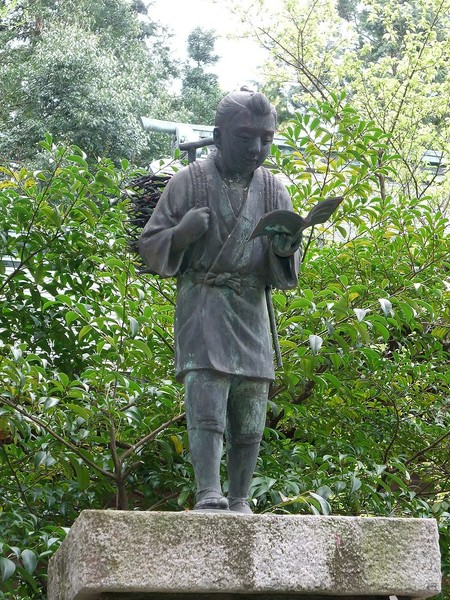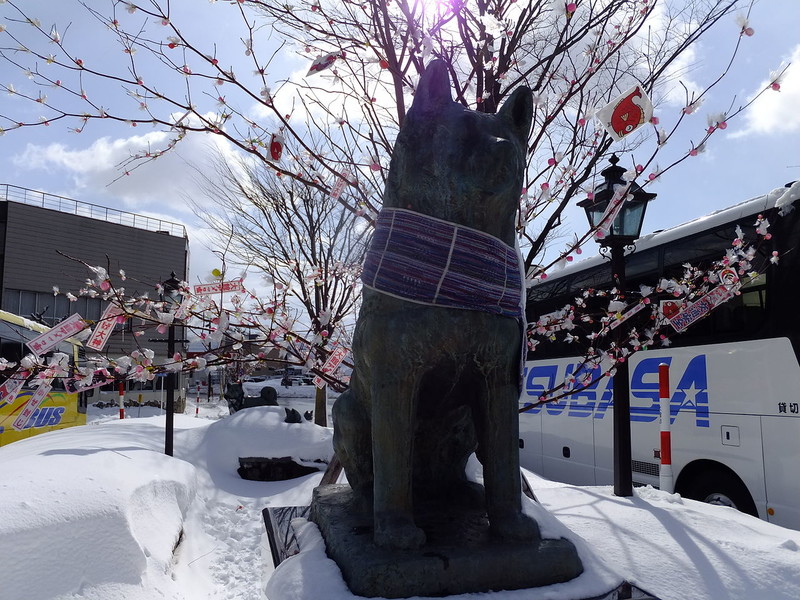Answerman
Why Are There Statues Of A Reading Boy And A Dog In Japan?
by Justin Sevakis,

Jake asked:
I was recently thinking about some of the school anime I have watched over the years and have noticed there are two or three statues I tend to see a lot pop up. One of the most common is a statue of a man reading a book with a bundle of wood on his back in front of school courtyards. Another I often see in public parks is a dog sitting on a pedestal. It makes me wonder why these are so common? What are their significance?
The statue of a boy with a bundle of sticks on his back while reading is a common sight in front of schools, especially elementary schools in Japan. The boy's name is Ninomiya Sontoku, a poor peasant from the Ashigarakami district of Kanagawa who lived in the late 1700s and early 1800s. Sontoku (whose actual name was Kinjiro) is revered as one of the great teachers and thought leaders of Japanese history. His deeds are made that much more impressive by the fact that he came from absolutely nothing.
Having lost both his parents by age 16, Sontoku came of age working his uncle's land, while frequently studying. Within four years he had restored some vacant land and re-established his household, eventually becoming a landlord. After successfully resuscitating a small local economy through his agricultural know-how, he was recruited to run Odawara Domain and then Sagami Province.
Sontoku left behind teachings of philosophies combining Buddhism, Confucianism and Shintoism, but his real achievement was in economics, developing something like a credit union system for farmers, and educating people who didn't have much experience with money on things like compound interest and land development -- something of a late-Edo period Suze Orman.
The dog, meanwhile, is much more famous among foreigners. Hachiko was an Akita belonging to an agricultural professor at University of Tokyo named Hidesaburo Ueno. Ueno lived in Shibuya, and commuted to work everyday by train. Every evening, Hachiko would walk to Shibuya Station and greet his owner upon his return from work.
One day in May 1925, Ueno suffered a brain hemorrhage while giving a lecture, and never came home. But every day, Hachiko continued to go to the station to wait for his owner (while avoiding station employees who treated him like a stray dog). One day a student of Ueno's (and Akita enthusiast) named Hirokichi Saito noticed the rare purebreed, and followed him home. There, he met Ueno's former gardener, Kuzaboro Kobayashi, who had adopted the dog.
Kobayashi told Saito why Hachiko went to the train station everyday, and Saito was moved enough to write not one, but several articles on the dog, who he would visit often. The story was an understandably compelling one: the dog's faithfulness and loyalty to his owner was deeply moving to most people that heard it. In 1932 one of those articles, in Asashi Shinbun, caused a sensation and turned Hachiko into a celebrity.
A bronze statue of Hachiko was erected at the entrance to Shibuya Station in 1934, the dog having become a national mascot of loyalty and faithfulness by that time, not to mention causing a boom in Akita ownership. Hachiko passed away in 1935 of both terminal cancer and heartworm. He had continued the ritual to Shibuya Station for nearly ten years.
Hachiko's skin was stuffed and put on display at the National Museum of Nature and Science in Ueno, but his other remains were cremated and buried with Professor Ueno. While the original statue at Shibuya Station was recycled for use in WWII, a replacement was commissioned in 1948 from the son of the original artist, which nowadays has its own station exit and is a popular rendez-vous spot. An annual memorial ceremony is held there every year on March 8th.
Another statue stands at a train station in Hachiko's hometown of Odate, and in front of the Akita Dog Museum there. A movie was made of the story in 1987 ("Hachiko Monogatari"), and an American film starring Richard Gere was made in 2009. Several children's books, including a few in English, have also been published. Hachiko references have found their way into Futurama and One Piece, and a parody of the Shibuya Station statue can be found in Persona 5.
Thank you for reading Answerman!
We are no longer taking question submissions. However, over the years we've answered THOUSANDS of your questions, and probably already answered yours! Check our our complete archives! Below are a few of the most popular ones...
- How do I be a voice actor?
- How do I get a job in the anime business?
- How do I get my ideas made into anime?
- Will _____ get a new season? When?? (New productions are a closely guarded secret until they're announced. I don't know anything Google can't tell you.)
- Is ____ a trend? When did that start? (Who knows -- you often can't tell these things until years afterwards.)
- How do I get in touch with __(famous anime person)__? (We can't help you.)
Anime News Network founder Justin Sevakis wrote Answerman between July 2013 and August 2019, and had over 20 years of experience in the anime business at the time. These days, he's the owner of the video production company MediaOCD, where he produces many anime Blu-rays. You can follow him on Twitter at @worldofcrap.
discuss this in the forum (15 posts) |

